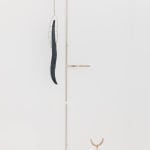Yeni Mao
83 1/2 x 21 5/8 x 18 7/8 in.
Further images
This wall-floor sculpture consists in a medical-like structure of nickel-plated steel that testifies the artist’s training in foundry work in California, and the architectural industries of New York. It features leather-wrapped handles that allude to its potential use in relation to the human body. Within this austere architectural conduit-like framework, a ceramic worm figure dangles, introducing an organic contrast to the structure’s clinical artificiality and stark geometrical lines. The incorporation of ceramics represents a relatively recent development in Mao’s practice, driven by the need of an organic element to the architecture of his pieces. The juxtaposition of the ceramic worm, alongside the unyielding steel structure, underscores the tension between nature and industry in the piece. Connecting these elements, the handles and leather create a symbolic bridge between the architectural form and the anatomical.
This wall-floor sculpture consists in a medical-like structure of nickel-plated steel that testifies the artist’s training in foundry work in California, and the architectural industries of New York. It features leather-wrapped handles that allude to its potential use in relation to the human body. Within this austere architectural conduit-like framework, a ceramic worm figure dangles, introducing an organic contrast to the structure’s clinical artificiality and stark geometrical lines. The incorporation of ceramics represents a relatively recent development in Mao’s practice, driven by the need of an organic element to the architecture of his pieces. The juxtaposition of the ceramic worm, alongside the unyielding steel structure, underscores the tension between nature and industry in the piece. Connecting these elements, the handles and leather create a symbolic bridge between the architectural form and the anatomical.









